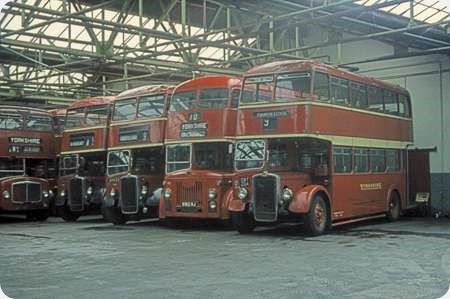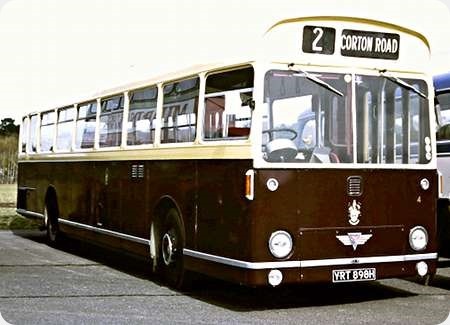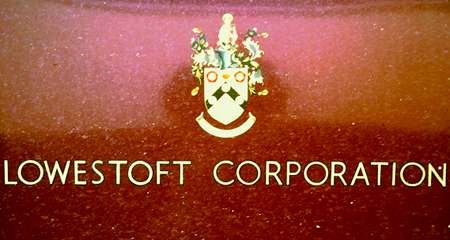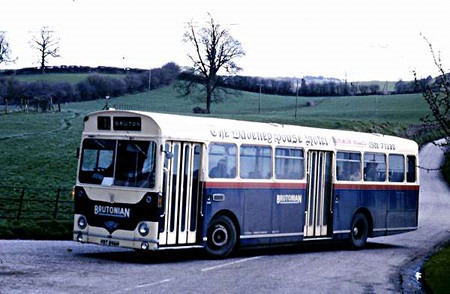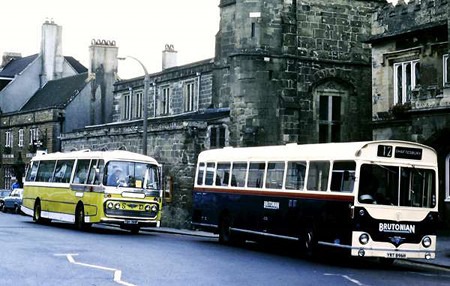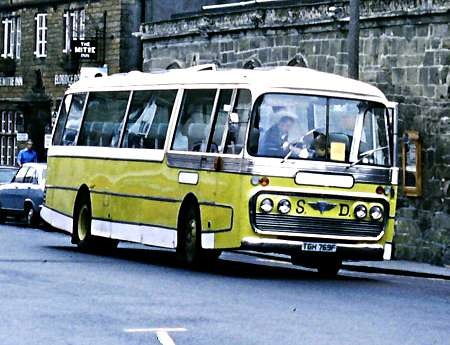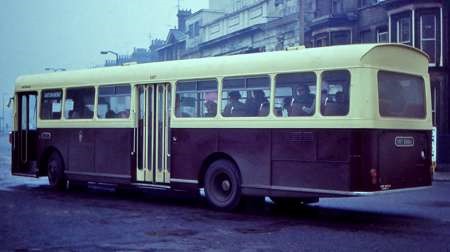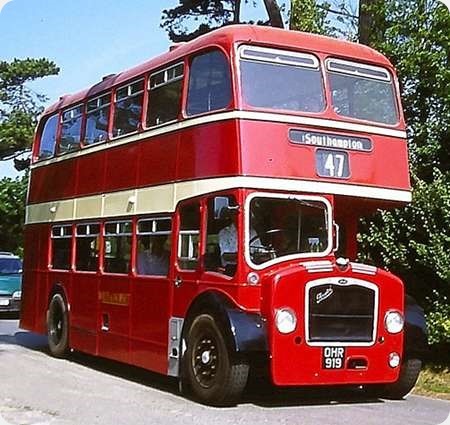Yorkshire Woollen District – Bristol K5G – OWT 204 – 154
Yorkshire Woollen District
1939
Bristol K5G
ECW H28/28R (1955)
Aliens Land In Dewsbury.
Yorkshire Woollen District experienced a severe shortage of vehicles during 1969 and consequently was obliged to acquire some most untypical vehicle types which no doubt caused much displeasure to both engineering and road staff. Seen here at Savile Town depot, Dewsbury in 1970 are a selection.
From the left.
WCY 892 (160) was one of seven AEC/PRV Bridgemasters (H43/29F) that had come from South Wales Transport, this one being new in 1961.
UHN 642 (166) and WHN 54 (169) were two of six Bristol KSW6B’s with ECW H32/28R bodies, that had been new to United Automobile in 1954/55.
6162 WJ (141) was one of seven Leyland PD2/30’s with Roe H33/26RD bodies that had been new to the Sheffield ‘C’ (British Railways owned) fleet in 1960. From the same source had also come two PD2/20’s with ECW bodies, three Atlanteans and two Burlingham-bodied Leopards.
OWT 204 (154) was one of four Bristol K5G’s with ECW highbridge bodies that had been new to York West Yorkshire in 1939, then rebuilt with new chassis frames and rebodied in 1955. There was also a pair of lowbridge K6B’s from Keighley West Yorkshire.
All those in the photo were withdrawn in 1970 (6162 WJ in 1972) and sold to North’s, the dealer, at Sherburn-in-Elmet only the Bridgemaster seeing further use, being exported to Canada for use initially by a restaurant in Toronto, then by Gray Tours of Winnipeg.
Photograph and Copy contributed by John Stringer
06/01/17 – 06:24
Hmm . . . varying shades of red! I’, assuming that Ks were placed in service in Tilling red, the Bridgemaster in SWT red, but the PD2 repainted into YWD red. I’ve seen a paint listing somewhere which refers to "BET red" and "BET crimson" as standard colours shared by BET companies: I’m sure YD used one of the two, and Hebble the other (and one of two was the same as Western Welsh) – I’ll have made a note somewhere, I’ll track it down.
It strikes me as odd that YWD went to the trouble of making "coach glasses" for the Bridgemaster and PD2, but not the UA Ks.
Philip Rushworth
06/01/17 – 10:51
Sorry to reveal my ignorance but what do you mean by "coach glasses"?
David Rawsthorn
06/01/17 – 10:52
I knew of the vehicle shortage at YWD but I’m surprised to find that such a variety of interesting vehicles were brought in to help. While I can understand the general displeasure among the work force, as an enthusiast driver I would have been over the moon at getting to know such vehicles.
Chris Youhill
06/01/17 – 10:53
Great photo John. Takes me back to when I started at YWD Head office at Savile Town Dewsbury in 1970. These buses made a welcome change to the MCW Regent Vs which seemed to be everywhere around Dewsbury. The Bridgemasters were christened Welsh Corgis.
J D Blackburn
07/01/17 – 06:44
David
Those glass panels with the operators names on below the rear windows of coaches, I couldn’t think of a better name for the glasses with "Yorkshire" in lieu of destination screens.
Philip Rushworth
08/01/17 – 06:21
Thanks.
David Rawsthorn
08/01/17 – 06:22
I guess the Ks, being considerably older, were considered to be "not long for this world"! I know beauty is in the eye of the beholder, but for me the ECW body for the K (especially the high bridge KSW version) was the nicest and best balanced half-cab double decker of all time. By contrast, I always thought the Bridgemaster was the ugliest (with apologies to those who love them!)
Stephen Ford
08/01/17 – 06:23
OWT 204 was actually the fifth ex York-West Yorkshire K5G that Yorkshire used. They started with OWT 196/7/201/5 from 1 May 1969 and numbered these 155/4/2/3 respectively. However, OWT 197 was returned to West Yorkshire (for disposal) at the end of May and replaced by OWT 204, the subject of the photo, which took on OWT 197’s fleet number of 154.
At this stage all six West Yorkshire vehicles (4 x K5Gs and 2 x K6Bs) were only on hire and carried a "West Yorkshire Road Car" legal ownership panel and an "On Hire to Yorkshire Woollen District" sticker. They also had "West Yorkshire" fleetnames (i.e. without Keighley- or York- prefixes) and full Tilling red and cream livery with black wings and wheels. This hire situation continued until 18 August 1969, when all six vehicles were sold to Yorkshire Woollen District.
In January 1970, OWT 196/201/4 had their wings and wheels painted red (ex black) and gained Yorkshire fleetnames, but remained in Tilling red and cream.
They were used mainly on YWD routes A1/2/3/4 (Thornhill-Dewsbury-Birstall), for which special short destination blinds were made for the front only; they carried no rear destination or route number blinds. They worked mainly at peak hours, but we were told at the time that they "…are extremely popular with the Yorkshire drivers, who appreciate their reliability and sturdiness. Indeed, they are practically the only double deckers at Dewsbury that do not have to be "booked off" for one fault or another!"
Trevor Leach
08/01/17 – 06:24
I have read before about the "severe vehicle shortage" in 1969 which may have been shared with others. Why was this? Do I remember that they had problems with inspections? In days of uniform fleets it is strange to read that these five "begged" buses had four different makes of engine- a Youhill delight- what was the rest of the fleet then? Leyland? At least I think West Riding- around then- replaced Wulfrunians with buses with various Gardner engines.
Joe
10/01/17 – 06:17
From memory, local newspapers referred to a shortage of spare parts.
In 1969 Yorkshire Woollen’s fleet included:
6 x circa 1950 Leyland PS2s rebodied as double-deckers by Roe in 1962-63
44 x AEC Regent Vs dating from 1958-61
9 x Leyland PD3A built 1962
14 x Albion Lowlander built 1964
22 x Daimler Fleetline built 1965-67
12 x Leyland Atlantean built 1967
Between 1959-62 Yorkshire Woollen purchased 43 AEC Reliance single-deckers, but many of these had been withdrawn by 1969.
YWD purchased 50 bus-bodied Leyland Leopards between 1962-65.
I well remember wishing to travel to school and finding that what had previously been a 70-seat Regent V-operated service was frequently a coach-seated AEC Reliance, either with 39-seat Weymann Fanfare bodywork, or ex-Maidstone & District examples with centre-entrance 37-seat Harrington coachwork.
I regret to say that things got so bad with being unable to even board a vehicle – and consequently being late for school – I finally gave up on YWD and started walking to school.
Paul H
10/01/17 – 16:49
I was aware that Hebble was experiencing severe problems with its fleet around this time (1970) but did not realise YWD shared the same problems.
The former Sheffield buses came to YWD as a result of NBC taking over the former railway-owned C fleet and distributing them to its subsidiaries, but no doubt they helped with the vehicle shortage.
Geoff Kerr
03/03/17 – 10:23
I left Dewsbury in 1968, but I don’t think that the situation was much better for 2 or 3 years before this. I well remember 41 seater Reliance/Harringtons being used on the A group of services to Thornhill where the allocation was a 70 seat Regent V every 5 minutes, with queues from the Market stop almost to the end of the road, and no chance of boarding the bus opposite the Bus Station. I am not sure that the cause was the same as 1969 but the effect certainly was. As an 18 year old I had a Saturday afternoon job with a Market Trader (I had to go to school Saturday morning), and I always walked to the Bus Station and caught one of the other services (Whitley, Grange Moor or Thornhill Edge) which took me close to home – and they were always full with frustrated A service passengers.
Malcolm Hirst
22/11/18 – 07:02
So bad was the state of the fleet in the late sixties that the road staff struck over the state of the vehicles one spokesman for the staff cited the PS rebuilds as the worst offenders Despite this they lasted well into the NBC era.
Chris Hough
24/11/18 – 06:15
The rebuilt PS2s also caused a lightening strike during the seventies. This was due to heaters not working. Sounds quite radical but it was probably the accumulation of vehicles constantly being "logged off" for this problem. I was working at Dewsbury head office at the time and remember having to walk home cursing everything.
John Blackburn
28/08/20 – 06:46
Was lucky enough to work for YWD in 1970 and doubly lucky to have missed driving a K5G up any hill in the area. 6 cylinder Gardner engined half cabs were bad enough but the thought of a 5 cylinder one only makes you think of trips you could miss with late running. Always found the ex Sheffield Leylands being a pleasure to dd felt quite tight vehicles and easy to drive. Really enjoyed the Corgi Bridgemasters unlike many drivers. Being tall the gear stick being at an angle was far easy to use in comparison to the Regent V where second gear was hard to engage due to being at the back of the bulkhead and a knuckle scraper.
Ian Gardner
15/10/22 – 06:04
I remember seeing one of the ex-Sheffield Titans freshly repainted into YWD red. Unfortunately the paint was rather thin and the Sheffield blue bands were still visible under it!
Glen Simpson
Quick links to the - Comments Page - Contact Page - Home Page
